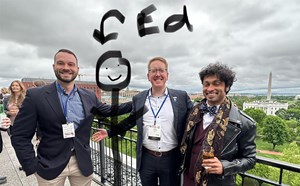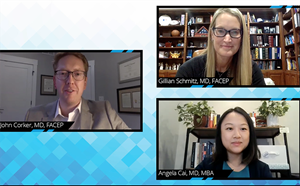
Understanding EM’s Evolving Workforce, Job Outlook
Q&A with Daniel Freess, MD, chair of ACEP’s Emergency Medicine Workforce Taskforce
By Benjamin Karfunkle, MD
The United States Emergency Medicine workforce has gone through serious changes since EM became recognized as a specialty in 1979. Initially EDs were staffed by physicians with no training in EM, as that training didn’t exist. Now, EM residencies are training more and more emergency physicians (EPs) every year, but there are still emergency departments relying on moonlighting internal medicine-trained physicians and advanced practice providers like nurse practitioners (NPs) and physician assistants (PAs) to fill the gaps.
At the 2018 ACEP Scientific Assembly meeting in San Diego, a taskforce was formed to study the EM workforce with a focus on how NPs and PAs are being integrated into emergency care across the country and to provide best practice recommendations back to the ACEP Council. The taskforce is reviewing every aspect of APP incorporation including APP preparedness for working in the ED, additional fellowship training for APPs in emergency medicine, the geographic distribution of APPs, and how the EM workforce is keeping up with increasing ED volumes overall.
I spoke with Daniel Frees, MD, EM Workforce Task Force chair and past YPS chair, about how the EM Workforce Task Force’s findings could affect those of us at the beginning of our careers.
Anecdotally, many new grads have told me they’ve been having trouble finding jobs in the larger cities of their choice after residency. What has the workforce taskforce seen so far about this? How do APPs seem to be affecting job outlook for EPs?
DF: There have always been places that are harder to get jobs, but as a nation we are FAR from being saturated for EP jobs. In fact, we’re unlikely to ever saturate the market without increasing the number of residency position by about a quarter. But how willing over time will EPs be to move out of the big cities and off the coasts? Will market forces eventually attract work? One of the arguments for NP and PA autonomy has been that they may go work at these underserved rural locations, but it doesn’t seem that this happens either! We have not seen research answering this question, and one of the things the task force will likely try to tackle is whether this is true.
A lot of the issues we hear regarding the practice of NPs and PAs does not tend to be in the big urban and academic centers as there are lots of learners, education, and oversight built in, but rather tends to be in community type practices where NPs and PAs are in more independent roles.
In the meantime, ED volumes are increasing at a rate such that we will always have jobs for EPs, though some of them may be moving further out from major cities.
Something many new grads worry about after their shifts is a stack of APP charts requiring our signatures, even though we never had an opportunity to see the patients. What is the workforce looking at regarding this issue?
DF: One of the biggest complaints that members bring to ACEP is that they feel they are forced to sign stacks of NP and PA charts for patients they never saw, and they fear that this is illegal or unethical. What we have found is that rarely is the physician’s signature really required for the chart. The vast majority of time this is not required. Look forward to some more specific information in the taskforce's report!
How does the spread of APP independent practice look to affect EM?
DF: While there is lots in the media about NPs and PAs as national groups seeking independence, both the American Academy of Emergency NPs (AAENP) and Society of Emergency Medicine Physician Assistants (SEMPA) do not advocate for independent practice of APPs in EM and instead advocate for APPs’ current roles in the ED rather than an independent role.
Anything you’d like to share looking back on your time with the Young Physicians Section?
DF: I’m glad that the section is so much larger and more active now compared to when I was chair! The chair before me expanded the section to the point that we filled one table of people at the meeting, I got it to two tables...and now the room is filling up! It’s a great group full of energetic people and I’m so thankful to have been a part of it.




